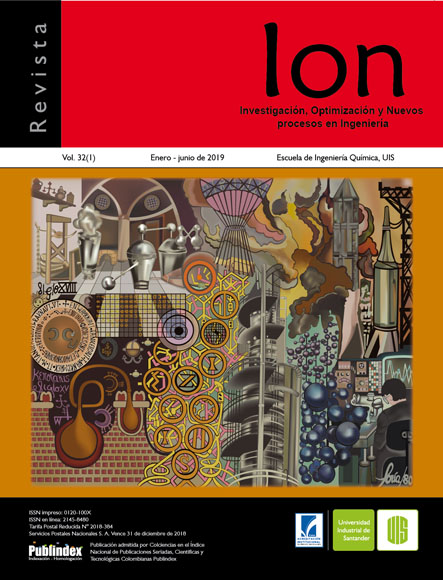Thermodinamical productivity limitations for passive solar stills
Published 2019-08-30
Keywords
- Desalination,
- Passive Solar Still,
- Solar Still Productivity,
- Solar Still Efficiency
How to Cite
Abstract
Seawater desalination is a process that has been widely studied with great interest due the growing water scarcity for human use. Solar distillation is a very ancient method, the productivity, energy requirements and the consequent cost of the desalinated water depends at least of the efficiency that can be reached in every single step of those systems. Due the limited solar irradiance absorption and to water evaporation transformation capacity, due to glass and water radiation absorbance and the ambient interaction, heat losses limit the overall thermal process efficiency and consequently productivity. Since in passive solar stills all energy comes from solar irradiation, this process maximum productivity will be limited for total solar irradiance that may be available in a defined zone of the world defined by their geographical localization, season of the year and local climatic conditions. All thermal process with this energy will be thermodynamically limited by heat transfer coefficient values reached in the dispositive, by the maximum value that can reach the evaporative heat transfer coefficient, and heat radiation and convective losses coefficients being minimum.
In this paper, comparative analysis is presented from several process proposed models, device reported data; solar irradiation reported data reaching about 7.2 – 7.4 kWh/m2 and estimations for productivity intervals for this devices area about 6.7 – 6.9 kg/m2d; efficiency calculated with available reported data are about 0.16 of the global solar irradiance.
Downloads
References
[2] Hernández H, Rubalcaba E, Hermosillo J-J. Improvement of a MEH desalination unitby means of heat recovery. Energy Procedia. 2014;57:2781-6.
[3] Moya EZ, editor Desalinización del agua del mar mediante energías renovables. Actas del I y II seminario del agua; 1997: Instituto de Estudios Almerienses.
[4] Tiwari G.N. SHN, Tripathi R. Present status of solar distillation. Solar energy. 2003;75:7.
[5] Moore BA, Martinson E, Raviv D. Waste to water: a low energy water distillation method. Desalination. 2008;220(1-3):502-5.
[6] Youssef P, Al-Dadah R, Mahmoud S. Comparative analysis of desalination technologies. Energy Procedia. 2014;61:2604- 7.
[7] Al-Weshahi MA, Tian G, Anderson A. Performance enhancement of MSF desalination by recovering stage heat from distillate water using internal heat exchanger. Energy Procedia. 2014;61:381-4.
[8] Darwish M. Qatar water problem and solar desalination. Desalination and Water Treatment. 2014;52(7-9):1250-62.
[9] Khayet M. Solar desalination by membrane distillation: Dispersion in energy consumption analysis and water production costs (a review). Desalination. 2013;308:89-101.
[10] Ma Q, Yi C, Lu H, Xie L, Fan J, He W. A conceptual demonstration and theoretical design of a novel “super-gravity” vacuum flash process for seawater desalination. Desalination. 2015;371:67-77.
[11] El-Sebaii A, El-Bialy E. Advanced designs of solar desalination systems: A review. Renewable and Sustainable Energy Reviews. 2015;49:1198-212.
[12] Asiedu-Boateng P, Nyarko B, Yamoah S, Ameyaw F, Tuffour-Acheampong K. Comparison of the Cost of Co-Production of Power and Desalinated Water from Different Power Cycles. Energy and Power Engineering. 2013;5(01):26.
[13] Hamed OA, Kosaka H, Bamardouf KH, Al-Shail K, Al-Ghamdi AS. Concentrating solar power for seawater thermal desalination. Desalination. 2016;396:70-8.
[14] Gabriel KJ, Linke P, El-Halwagi MM. Optimization of multi-effect distillation process using a linear enthalpy model. Desalination. 2015;365:261-76.
[15] Compain P. Solar energy for water desalination. Procedia Engineering. 2012;46:220-7.
[16] Abdelmoez W, Mahmoud MS, Farrag TE. Water desalination using humidification/dehumidification (HDH) technique powered by solar energy: a detailed review. Desalination and Water Treatment. 2014;52(25-27):4622- 40.
[17] Abdallah SB, Frikha N, Gabsi S. Study of the performances of different configurations of seawater desalination with a solar membrane distillation. Desalination and Water Treatment. 2014;52(13-15):2362-71.
[18] Cooper P. The maximum efficiency of single-effect solar stills. Solar Energy. 1973;15(3):205IN1215-214217.
[19] Kumar S, Tiwari G. Estimation of convective mass transfer in solar distillation systems. Solar energy. 1996;57(6):459-64.
[20] Goosen MF, Sablani SS, Shayya WH, Paton C, Al-Hinai H. Thermodynamic and economic considerations in solar desalination. Desalination. 2000;129(1):63-89.
[21] Mullick S. Estimation of heat-transfer coefficients, the upward heat flow, and evaporation in a solar still. Journal of solar energy engineering. 1991;113:37.
[22] Aboul-Enein S, El-Sebaii A, El-Bialy E. Investigation of a single-basin solar still with deep basins. Renewable Energy. 1998;14(1-4):299-305.
[23] Ho-ming Yeh N-tM. Energy balances for upward-type,double-effect solar stills. Energy. 1990;15(12):9.
[24] Imad Al-Hayek OB. The effect of using different designs of solar stills on water distillation. Desalination. 2004;169:7.
[25] ESMAP, cartographer World GHI Global horizontal Irradiance Poster map [Map]. www.worldbankgroup.com: Solargis; 2017.
[26] Yeh H-M, Ma N-T. Energy balances for upward-type, double-effect solar stills. Energy. 1990;15(12):1161-9.
[27] Sampathkumar K, Arjunan T, Pitchandi P, Senthilkumar P. Active solar distillation—a detailed review. Renewable and Sustainable Energy Reviews. 2010;14(6):1503-26.
[28] Dunkle R. Solar water distillation: the roof type still and the multiple effect diffusor. Int Dev in Heat Transfer;(). 1961.
[29] Smith JM, Van Ness HC, Abbott MM, García CR. Introducción a la termodinámica en Ingeniería Química. 7ma ed. Mexico: Interamericana M-H; 2007.
[30] Cengel Y. Transferencia de calor y masa. 3a ed. Mexico: McGraw Hill; 2007.
[31] Setoodeh N, Rahimi R, Ameri A. Modeling and determination of heat transfer coefficient in a basin solar still using CFD. Desalination. 2011;268(1):103-10.
[32] Shukla S, Sorayan V. Thermal modeling of solar stills: an experimental validation. Renewable Energy. 2005;30(5):683-99.
[33] Tiwari G, Shukla S, Singh I. Computer modeling of passive/active solar stills by using inner glass temperature. Desalination. 2003;154(2):171-85.
[34] Mowla D, Karimi G. Mathematical modelling of solar stills in Iran. Solar Energy. 1995;55(5):389- 93.
[35] Dev R, Tiwari GN. Characteristic equation of a passive solar still. Desalination. 2009;245(1-3):246-65.
[36] Perry R. GD. Perry’s Chemical Engineers Handbook. 8 ed. Hill M, editor. New York: McGraw Hill; 2008 2008. 2735 p.
[37] Dev R, Tiwari G. Characteristic equation of a passive solar still. Desalination. 2009;245(1-3):246-65.

